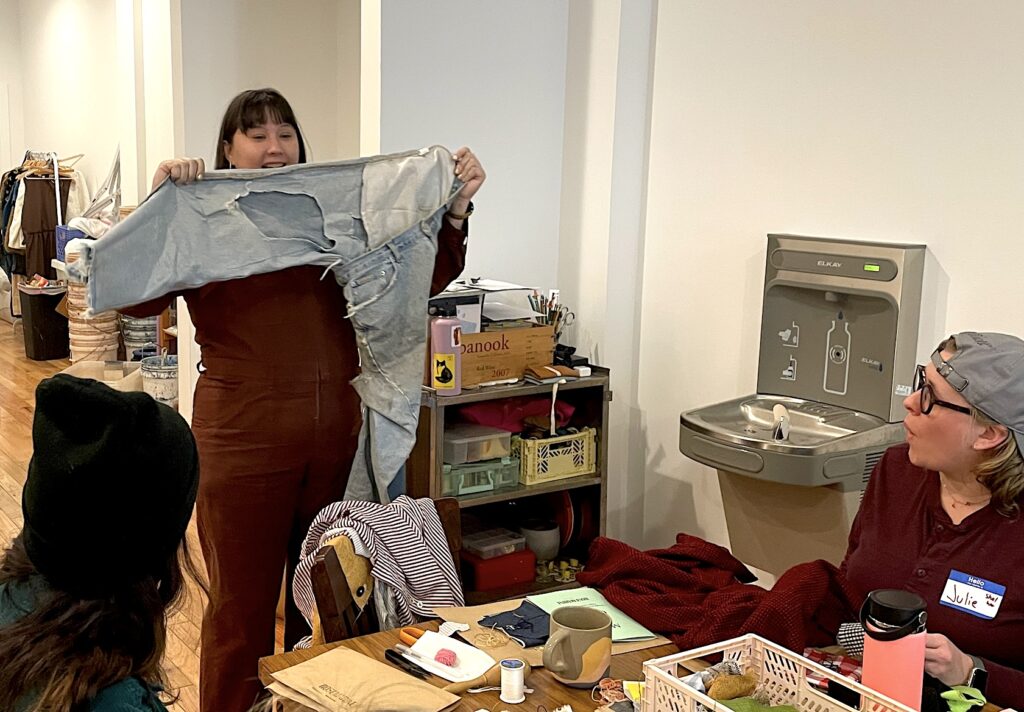Overview:
- Meg Navoy, founder of Rosemarine Textiles, is hosting workshops on extending clothing life, patching jeans, and using plant-based dyes to revive stained tops.
- Navoy aims to build a community sewing and fiber arts center to promote clothing care and reduce textile waste.
- These beginner-friendly workshops offer a fun way to personalize and maintain your wardrobe.
Textiles are at the heart of Meg Navoy’s workshops, where hands-on learning starts with the basics.
“Has anyone ever sewn on a button before?” she asked participants on a recent snowy Sunday afternoon. The nine gathered, each fumbling with a needle and thread, shook their heads.
Navoy is the founder and owner of Rosemarine Textiles, a Detroit-based sustainable textile studio offering workshops and home goods and accessories dyed with plant-based colors.
Her workshops teach participants how to extend the life of their clothing, like repairing old jeans with a patch or reviving a stained top with a fresh indigo dye. Participants learned the basics of mending clothing: sewing on a button, patching a hole, and darning socks.
This workshop is part of Navoy’s transition into a community sewing and fiber arts center, which includes weekly workshops and memberships for sewing and dyeing activities. Although she “fully believes” in her handmade home goods and accessories, Navoy said she feels more fulfilled sharing about craft versus the sales and product-based part of her business.

“I’m in a bubble of crafty sewing people, but there’s so many people who don’t know any sort of sewing or mending techniques at all, or the origins of how clothing is made,” Navoy said.
Navoy said once someone understands the work that goes into sewing, they start to view clothing as something they want to take care of, “instead of something that’s disposable, which is the main viewpoint on clothing for the last 20 plus years.”
Textiles generated over 17 million tons of waste in 2018, according to an EPA report. Residents living near landfills could be exposed to air pollutants such as methane, carbon dioxide and other contaminants, including volatile organic compounds that could lead to respiratory illnesses, a study found.
Sunday was the third time Navoy has hosted a mending workshop. She said it’s suitable for “total beginners.” The participants’ skill levels ranged from expertise in felting to threading the needle, being one participant’s “worst enemy.”
Each person received a mending kit with buttons, needles, thread, embroidery floss, safety pins, scrap fabric, small bird-shaped embroidery scissors, and an instructional zine with illustrations on sewing a button, patching a hole and darning a sock. Navoy tries to accommodate different learning styles in her in-person classes with visual, written, and oral alternatives.
“It’s really fun to learn as a group,” Navoy said. “You can see someone is getting creative with red thread patching a hole in their jeans or choosing a totally different fabric that clashes with the elbow hole in their shirt.”
Textiles should last
A graphic apparel designer, Megan Erickson, attended the workshop after discovering it on Instagram. She said she has a growing interest in sustainable fashion, driven by her disillusionment with the fast fashion industry’s rapid production cycles and poor-quality materials.
Erickson worked for a prominent Columbus-based fashion company, where she observed the intentionally short lifespan of clothing that led consumers to repeat purchases.
“They want people to continue to come back and buy more. It always kind of rubs me the wrong way,” she said.
This experience led Erickson to seek more ethical and sustainable alternatives in the apparel industry and incorporate those practices into her own life.
“I’m really interested in the longevity of clothing and how to make what we own last longer, especially with the ways that clothes are manufactured now; they’re not made to last,” Erickson said.
Fast fashion giant Shein adds 1,000 new designs a day, mostly polyester, manufactured with an oil-based polyethylene terephthalate, a type of plastic. A majority of microplastic pollution comes from fiber.

Plastic pollution may take 100 to 1000 years to decompose and carcinogenic chemicals found in plastic products can leach into tap water, which may cause developmental, reproductive, neurological, and immune disorders, a report found.
To demonstrate the patching technique, Navoy showed participants a pair of jeans she “wasn’t ready to call in yet,” covered in large patches of scrap jean material.
“These jeans are fighting for their life,” Navoy said. “It’s nice to have a pair that are your workhorse jeans.”
Navoy said if a button falls off a sweater but the rest of the piece is intact, it’s common for people to throw a garment away because they don’t have the knowledge or time to fix it themselves. Other than the rewarding feeling of mending something yourself, Navoy said, she highlighted mending as a financial solution.
“A lot of people are struggling financially, and to be able to save money on fixing your own things, instead of having to go out and buy a new thing can make a big difference,” Navoy said.
Navoy said giving clothing a new life with visible mending can be fun, too, as you channel your creative expression and make your clothing items your own.
Sarah Flees, a transportation manager and volunteer for a slow fashion trading app called Lucky Sweater, has attended multiple Rosemarine Textile workshops. At an indigo dye workshop, she learned to dye socks and a cream-colored jacket that she was “too afraid to wear” for fear of stains.
Flees practices wet and needle felting art, and bought Navoy’s marigold dye kit to learn how to repurpose her marigold harvest at the end of the year. She aims to expand her sewing technique knowledge.
“It is so easy to be like, ‘Oh, my T-shirt has a hole. I’ll just pop over to Target and get another $5 one,’’ Flees said. “I’m not gonna judge somebody else. But there is a cost to it, and I think most people don’t see the back end of it.”
Navoy is offering several more workshops in coming weeks, including a free knitting circle at her studio in Hamtramck and no-cost classes at the Ann Arbor District Library. Workshops cost $45 per person, though she offers a sliding scale pricing for those needing it.
“Don’t feel disempowered or limited in your capacity if you only know how to sew a button or how to sew a straight line,” Navoy said. “You can do a lot with that, and it’s a great jumping-off point.”
learn more
Scaling up textile recycling in Detroit
The fast fashion industry generates enormous waste, with many fabrics ending up in landfills or incinerators. This Black woman is part of the solution with textile recycling in Detroit.
Your grandmother’s crocheted tablecloth is having a moment
This local artist is upcycling textiles as a design solution to an environmental problem.
Craftsmanship meets storytelling at LiTO resale shop in southwest Detroit
Yvonne “Heaven” Montero, founder of LiTO in Southwest Detroit, has turned her passion for vintage fashion into a thriving resale business, emphasizing craftsmanship, storytelling and sustainability.




